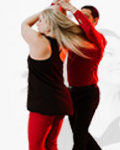One of the distinguishing features of west coast swing is the elastic look and feel of the dance. This effect of stretching away from each other before moving in the same direction is distinct from the rock step motion that characterizes other forms of swing.
Most dancers first learn about elasticity on the anchor. At the end of the anchor, both partners settle away from each other in a stretched position. The follower continues this stretch for a brief moment as the leader begins to lead the next pattern; this subtle away action creates the elasticity of the dance.
At higher levels of the dance, elasticity occurs with almost every change of direction or speed. For example:
- At the start of a new pattern, the follower will stretch away from the leader before moving forward.
- During the coaster step of the whip, the follower will stretch away from the leader before coming over the right foot on count 4.
- When coming up from a hip catch, the follower will sink into the caught hip before coming out of the catch.
- When exiting a throwout, the follower will stretch into the connected arm before coming towards the leader.
- When traveling past the follower, the leader will stretch into the connection before initiating the next pattern.
- When finished playing, the partner initiating the play will settle away in order to indicate that he or she is ready for the next movement; the other partner will match that settle in order to prepare the momentum for the next movement.
- Whenever either partner is in a neutral connection, both partners will stretch into the connection before initiating the next movement in order to avoid a rough or jerky motion.
Although the mechanic is reversed in compression, the same idea—that the connection builds slightly before the follower is moved—occurs in compression-based movements like push breaks, tucks, and exits from wraps and folds.
Developing elasticity requires practice in connection, maintaining frame, center movement, rolling through the feet, and anchoring.




 Brian & Megan
Brian & Megan